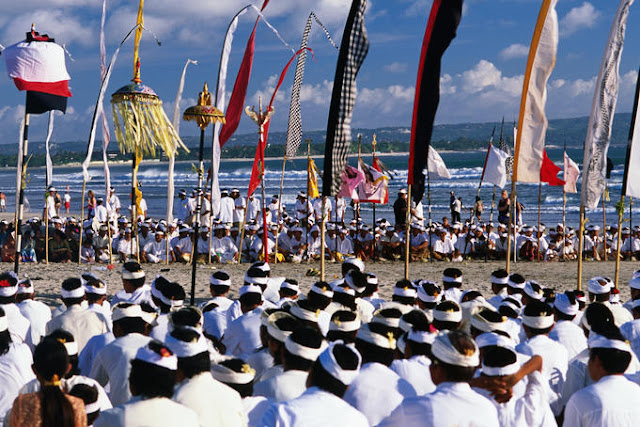Before the Balinese Hindi people perform “Nyepi”—The
Silent Day, a Hindi’s sacred day–, there is a ritual of praying which have to
be done that is called “Melasti” or “Melis”, a ceremony to clean up
“pratima”–the sacred property of the temple—at any nearest water fount, such as
sea as well as lake. People of Balinese Hindi who live around beach
usually perform the ceremony “Melasti” with seawater whereas they who live
around the mountain usually perform it by the lake water. “Melasti” was held at
almost every beach in Bali such as Kuta, Jimbaran, Tanah Lot, also Nusa Dua,
Batu Bolong in Canggu where as Denpasar people commonly perform it at
Padanggalak Beach which located in Sanur Beach area.
Melasti
Ceremony is a Hindu religious ceremony to
purify Bhuana Alit (small world) andBhuana Agung (the universe). This ceremony is
performed with a parade procession followed by thousand of Hindu people by
bringing all the equipment ceremonies and the symbol of gods to the sea or
other water sources that are believed by Hindus as a place to purify all the
elements of this universe. The usual symbols of gods brought to the sea are
Keris, spears, banners (Umbul-umbul), statues, Barong etc. This procession is
one of the unique Hindu ceremonies where the procession was followed by
thousands of Hindus who wear the clothes and other accessories in white to
indicate the purity.
postingan ini dapat ditemukan di www.feelinbali.blogspot.com
Melasti is the annual washing of the temple implements before the biggest
day of the year, Nyepi Day, which is tomorrow. Priests and banjars from every
part of Bali have to wash their temple equipment in the sea as part of a ritual
cleansing and Pura Petitenget is ideally placed to handle large crowds with
easy access to the temple and the ocean. Balinese temple ceremonies involve
plenty of offerings made of flowers and other natural products. The Melasti
ceremony left the beach covered in trampelled offerings and somewhat like a
waste dump. Not to worry I guess if its all bio-degradable and the sea takes it
out.postingan ini dapat ditemukan di www.feelinbali.blogspot.com
The purpose of this Melasti ceremony is to purify Bhuana Alit (small world) and Bhuana Agung (this universe) from bad influences, bad deeds and bad thoughts. Bhuana Alit (small world) is meaning the heart / soul of each individual who lives in this world while Bhuana Agung was the wide world or this universe. This ceremony is very important value to remind /realize how important this life and we need a day to purify ourselves and the universe. With this ceremony, all the components that live in this world have a clean soul so the world can survive from the threat of a bad thing.
The ceremony was ended with a ritual of encircle the beach. As the age shifts and for some considerations, this ritual does not any longer applied as walking encircle through along the seaside. According to Agung from community of sub-village Kangin (Banjar Kangin) of Denpasar—one of the practitioner–the beach encircling ritual, nowadays, symbolically appears by walking encircle the spot of the ceremony “Melasti” only. People of each “banjar” alternately walking carried each of their “pratima” for some circling. A flamboyant banners, magnificence flags, serenely traditional umbrellas, various antique package of offerings, and more sacred symbols of each of temple was lifted up above their head, momentary impressing a gush of majesty, splendour, and vigour of them those were celebrated ‘respected’ yet full of humility—in a folksy way, solemn, and–once again—almost silent.
Melasti ceremony held once a year to coincide the welcome of Nyepi Day / Silent Day. Melasti procession is usually held four / three days before Nyepi / Silent Day. This is done because in accordance to the purpose of this ceremony where before Nyepi Day that all the elements at Bhuana Alit and Bhuana Agung should be clean and pure. This is very important because the feelings / heart clean and pure, we can implement Nyepi Day perfectly.
Every “banjar” that has done with the “encircling beach” ritual continued their cavalcade toward their own temple to put their “pratima” back. As like as their arrival so does their homing, they went back to their temple by feet. Cavalcade of Balinese Hindus people within white nuance clothing carrying the sacred worship symbols—pratima—once again enliven along the road of Sanur-Denpasar. Colourful of magnificence, majesty, and splendour of Bali wrapped by such a white nuance of purity move and march as if fence in the coast of Padanggalak Beach, Sanur Beach area, Badung District, Bali.










